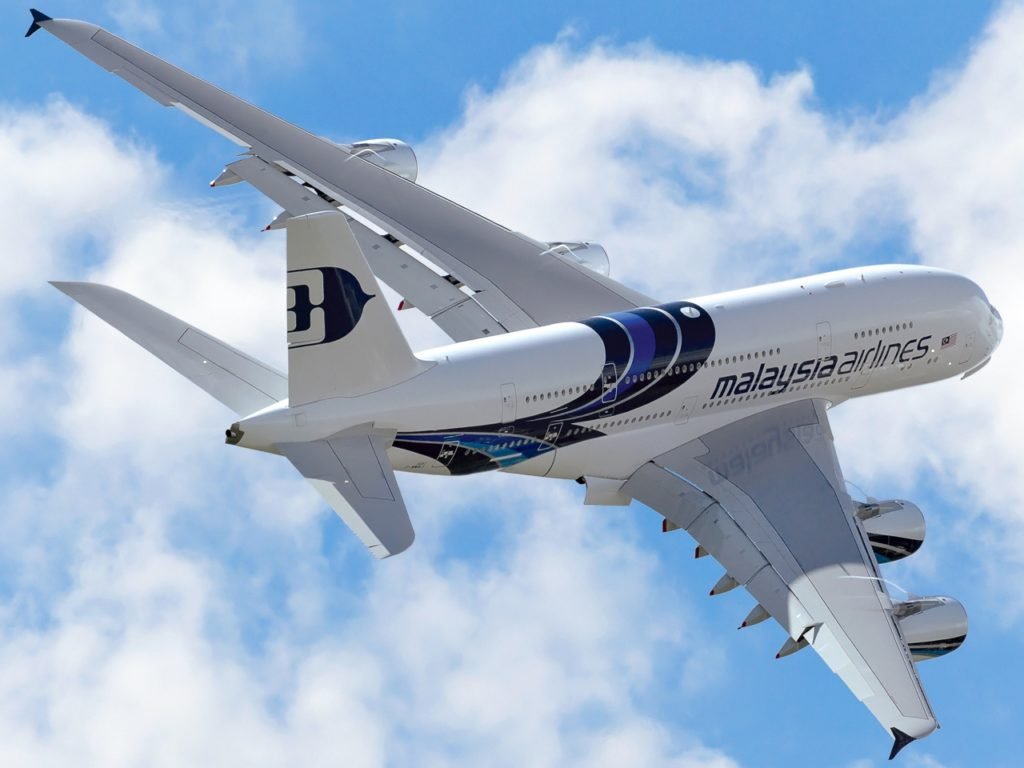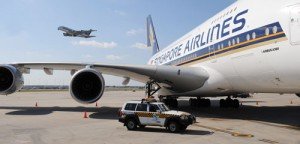
Template.
SPECS
ASSEMBLY
INTERIOR
HISTORY
ORDERS
The Airbus A380 started as far back as 1988 when Airbus, an EADS company, realised that they needed to come up with an answer for the stranglehold that Boeing had over the upper end of the aviation market with the Boeing 747. At the 1990 Farnborough Airshow, the Mega Project was announced. Designers from Airbus's four partners Aérospatiale, Deutsche Aerospace AG, British Aerospace, and CASA were invited to put forward new technologies that might be incorporated into this project.
In 1993 Boeing and several Airbus-related companies formed a feasibility study group for a Very Large Commercial Transport (VLCT). This was seen as a small market and one possibly not worth pursuing by one company alone. Boeing dropped out after two years as they saw that the investment was very unlikely to be recouped by sales later on, so they continued plans to further stretch and develop the Boeing 747.
Airbus in June 1993 began the development of their own large airliner which was designated A3XX. Several unusual designs were put forward, one being the twin fuselages of two A340s attached side by side. The Asian economic downturn of the late 1990s prompted the design to not only be very large but also to concentrate on the reduction of operating costs. Airbus targeted a 15% drop in running costs for this new design.
A newly restructured Airbus Industrie on 19 December 2000 voted the EU 8.8 Billion program into being and the A3XX was re-designated the A380. The logical progression of the Airbus type number should have made it the A350 as the A340 was the then-latest Airbus design. It was decided that the number 8 best represented the layout of the twin-deck design, as well as being a lucky number in Asia which was the target market for this aircraft.
Singapore Airlines was the launch customer for the Airbus A380 with their first route being the Singapore to Sydney, Australia run.
The A380 design was finalised in early 2001, and the first structural components were laid down on 23 January 2002.
Airbus intended to offer the A380 initially in two versions:
The A380-800 which in a three-class configuration can carry 555 passengers or if configured as all economy this can raise the total to 853. In May 2007 Airbus also offered a configuration with 30 fewer passengers which added a further 370Km (200 nautical miles) to its range. The range of this aircraft is 15,400Km (8,300 nautical miles) which is equivalent to flying Hong Kong to New York.
The A380-800F which was designed to carry 150 tonnes of cargo over a range of 10,400 Km (5,600 nautical miles) was put on hold while Airbus concentrated on the passenger side of the market. The cargo idea was never reinvestigated.
There was also an A380-900 stretch version on the drawing board which could carry 656 passengers in a three-class configuration or 960 passengers in an all economy version. The current wing area already is rated for the extra weight this would incur, however, strengthening of certain areas would still need to be undertaken. As we now know, this idea also never saw the light of day.
Airbus Industrie is a consortium formed by E.A.D.S. and BAe Systems. E.A.D.S., the European Aeronautic Defence and Space Company, was formed by a merger of Aerospatiale-Matra of France, Daimler-Chrysler Aerospace of Germany, and CASA of Spain (former members of Airbus). In October 2006, BAe Systems completed the sale of its shareholding to E.A.D.S., which is now the sole owner of Airbus.
ASSEMBLY
SPECIFICATIONS
The A380-800 as the Airbus A380 Specs table below will show, has a standard seating layout for 555 passengers on two decks in a three-class configuration. This varies from airline to airline. QANTAS, for example, has fitted its aircraft out with 523 seats in three classes. The A380 has 49% more floor area but only 35% more seats than the Boeing 747-400 which it was set to compete against (this is in the 555-seat configuration). This was envisaged to allow more room for passenger amenities such as bars, gymnasiums, and duty-free shops at the airline's discretion. Of course, these amenities are all very well at the conceptual stage, but economic pressures add a bit of a reality check and to date, no airline has added these amenities, save for First Class cabins on Emirates and Singapore Airlines.
……. Specs Table
History.
The 555 seat, double deck Airbus A380 aircraft is the most ambitious civil aircraft program yet. On entering service in October 2007, the Airbus A380 was and is the world's largest airliner, easily eclipsing Boeing's 747.
Airbus first began studies on a very large 500 seat airliner in the early 1990s. The European manufacturer saw developing a competitor and successor to the Boeing 747 as a strategic play to end Boeing's dominance of the very large airliner market and round out Airbus' product line-up. Airbus began engineering development work on such an aircraft, then designated the A3XX, in June 1994. Airbus studied numerous design configurations for the A3XX and gave serious consideration to a single deck aircraft which would have seated 12 abreast and twin vertical tails. However, Airbus settled upon a twin deck configuration, largely because of the significantly lighter structure required. Key design aims include the ability to use existing airport infrastructure with little modifications to the airports, and direct operating costs per seat 15-20% less than those for the 747-400. With 49% more floor space and only 35% more seating than the previous largest aircraft, Airbus is ensuring wider seats and aisles for more passenger comfort.
Using the most advanced technologies, the A380 is also designed to have 10-15% more range, lower fuel burn and emissions, and less noise. The A380 would feature an advanced version of the Airbus common two crew cockpit, with pull-out keyboards for the pilots, extensive use of composite materials such as GLARE, and four 320 to 347kN (72,000 to 78,000lb) class Rolls Royce Trent 900 or Engine Alliance (General Electric/Pratt and Whitney) GP-7200 turbofans.
Several A380 models were planned: the basic aircraft is the 555 seat A380-800 and high gross weight A380-800, with the longer range A380-800R planned.
Future models were to include the shortened, 480 seat A380-700, and the stretched, 656 seat, A380-900. (The -700, -800, and -900 designations were chosen to reflect that the A380 will enter service as a fully developed aircraft and that the basic models will not be soon replaced by more improved variants). A380 final assembly took place in Toulouse, France, with interior fitment in Hamburg, Germany. Major A380 part assemblies are transported to Toulouse by ship, barge and road.
First 2 Airbus A380s of Singapore Airlines pass each other in Sydney
The A380 Airbus interior has twin-aisle cabins on the upper and lower decks, with 49% more floor space for 35% higher seating capacity compared to the Boeing 747-400.
A three-class layout provides 555 seats. A typical upper deck layout provides 96 business- and 103 economy-class seats. The main deck provides 22 first-class seats and 334 economy-class seats.
Two stairwells link the passenger decks. A lifting system between passenger decks provides access for passengers with limited mobility. There is also a cargo hoist linking the two passenger decks.
The size of the Airbus A380 makes possible a number of configurations and passenger facilities. Singapore Airlines (launch customer) has a configuration for 471 passengers – 12 first-class 'suites' and 311 economy seats on the main deck, 60 business class seats and 88 economy seats on the upper deck.
Naturally, every airline customer will have their own cabin layouts, furnishings, and colours chosen when they order their version of the Airbus A380. Airbus has showcased some of the modern advances in aircraft interior design and technology creating a sensation of freshness and space…
Cabin Interior.
Orders and Deliveries.
Airbus announced in February 2019 that the production of the Airbus A380 would cease in 2021. After eleven years due to the soft Airbus A380 Orders and Deliveries, Airbus has made the hard decision.
When the A380 was launched, it was anticipated that 1,200 of the type would be produced, which would have covered development, construction and profit. The truth is that less than a quarter of that number were ordered. In the last months, we have seen airlines cancel their orders. Notably, QANTAS who received 12 of the 20 they ordered, has now cancelled the remaining 8. Virgin Atlantic cancelled their order of 6. Even Emirates, the largest customer of the type with an order of 162, are talking about reducing this order in favour of the Airbus A350-1000.
So why has the A380 not sold? There are several factors. Firstly, the expense of an aircraft that requires 4 engines to run. The overhead is far higher than the large twin-engine jets which are becoming more popular. Airlines are also challenged to fill each flight with over 500 seats to ensure profitability. In addition, airfields that can accommodate the Super Jumbo had to be heavily modified to accommodate the large jet. The theory behind the use of the A380 was dependent on a hub and spoke system. The A380 would fly between main hub cities. Travellers would then connect on to smaller regional centres. The emerging reality, however, is that many of the larger long-range twin jets can fly virtually anywhere using existing airfield facilities.
So it seems, just like the Boeing 747 8i, the A380 has been overtaken by changes in technology and market demand. The time of the oversized airliner is over.













